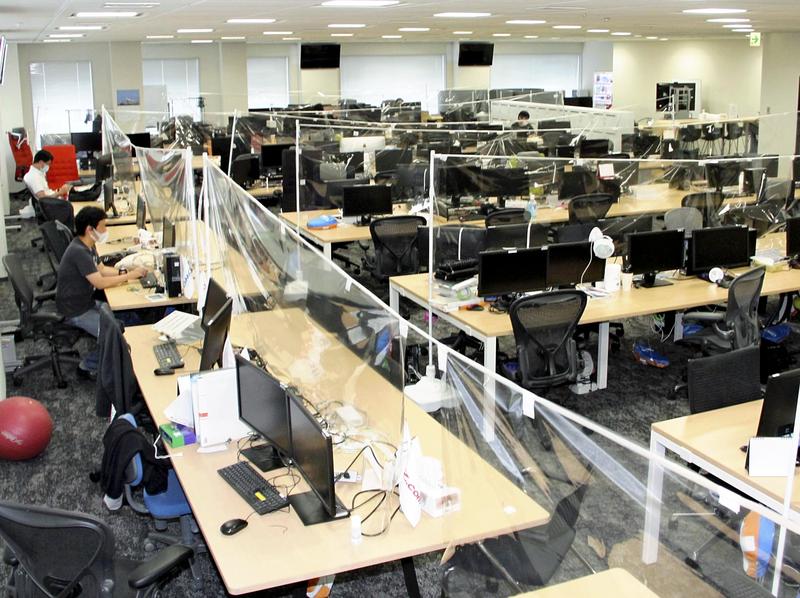
As the number of novel coronavirus infections rebounds, the government will soon once again request the economic world to increase their percentage of employees teleworking to 70%. However, it is not expected to be an easy task.
While progress has been made to introduce teleworking systems at major corporations and within the information technology industry, no more than 30% of their employees worked from home in April and May, during the declared state of emergency. Achieving the 70% target is a challenge for companies, especially for small-to-midsize firms that are conspicuously slow to adopt teleworking systems.
In July, Fujitsu Ltd. decided, in principle, to have about 80,000 of its domestic employees telecommute, a policy it plans to maintain, even once the virus outbreak is brought under control. Instead of paying for commuter train passes, the company began subsidizing 5,000 yen a month to cover expenses, such as electricity, which can increase due to working from home.
GMO Internet, Inc. and Hitachi, Ltd. have already met the 70% goal and plan to fully introduce a teleworking system in the future. As both corporations specialize in IT, there were few constraints in the establishment of teleworking in terms of facilities and other technical matters.
In late July, Itochu Corp. announced that it would, in principle, allow all of its 3,000 employees in Japan to work from home. During April and May, the company had all of its employees engage in teleworking but reverted to its original system, in which they commute to the office, once the state of emergency was lifted. However, as the number of infections started to pick up once again in July, the company was forced to make frequent minor changes depending on the infection status, such as halving the number of employees coming to the office.
At a July 26 press conference, Yasutoshi Nishimura, minister in charge of economic revitalization, reported that the number of those teleworking has decreased compared to the figure seen during the state of emergency. "We would like [corporations] to unwaveringly continue their efforts to implement a teleworking option for 70% of their employees," he said.
The government intends to soon request three economic entities, including the Japan Business Federation (Keidanren) and the Japan Chamber of Commerce and Industry (JCCI), to further their efforts to promote teleworking.
However, Japanese companies as a whole, including small-to-midsize companies, have lagged far behind.
According to a nationwide survey conducted by the Health, Labor and Welfare Ministry and Line Corp., even among employees in administrative posts, such as planning and development positions, only 27% of them engaged in teleworking in April, when the state of emergency was in effect. Even among prefectures that boast higher numbers of teleworkers, their percentages fell far below 70% -- with Tokyo at 52% and Kanagawa Prefecture at 44%. Figures below 10% were seen in 33 prefectures.
Companies with facilities such as factories and workshops face even greater constraints. "It is difficult for the entire company to achieve the 70% target, due to us having field sites [such as power plants]," said an official of Tokyo Electric Power Company Holdings, Inc.'s public relations section.
For small-to-midsize companies, the hurdles are even higher.
"At small-to-midsize companies, there are cases of a single employee being in charge of both sales promotion and accounting. For such employees working from home is difficult as separating their two tasks is a challenge," said Kiyoyuki Yamauchi, the head of infectious disease countermeasures at the JCCI.
In many cases, reducing the number of employees in charge of sales promotion is believed to have a direct negative impact on business performance and some companies lack the know-how and leeway to make investments to establish a teleworking system.
"Without cash handouts or any other financial support from the government, it's hardly feasible to have 70% of employees telework," said an executive of an organization of small-to-midsize businesses.
However, the introduction of teleworking systems is thought to be inevitable should the future growth of the Japanese economy be taken into consideration. According to a survey conducted by the Internal Affairs and Communications Ministry in 2016, the labor productivity of companies that adopted a teleworking system was 1.6 times higher than those that did not.
Read more from The Japan News at https://japannews.yomiuri.co.jp/







